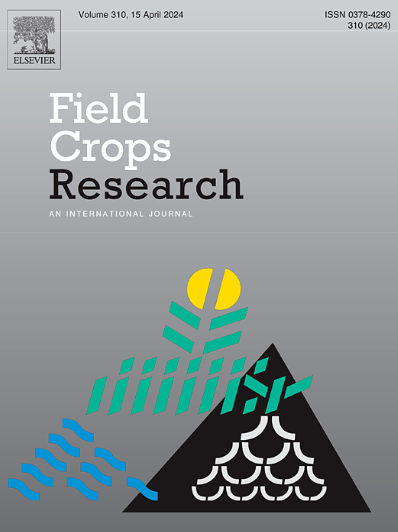整合数据同化与叶绿素荧光特征:实时监测作物氮动态的创新框架
IF 6.4
1区 农林科学
Q1 AGRONOMY
引用次数: 0
摘要
作物器官水平氮(N)动态(积累和运输)与最终品质和产量密切相关。传统的作物氮素监测方法要么具有很高的不确定性(作物模型),要么诊断茎和籽粒氮素状况的能力有限(遥感工具)。数据同化克服了作物模型和遥感工具的不足,但能否准确模拟农田尺度上的氮素动态仍是未知数。目的建立作物模型与无人机(UAV)遥感相结合的新型双同化框架,结合荧光信息加强作物氮素动态监测。方法首先,根据灵敏度分析结果选择WOFOST参数,并通过优化算法进行标定;其次,利用机器学习和多任务神经网络(mmdnn)构建叶面积指数、LAI、叶片干物质,LDM;叶片N积累,LNA;基于无人机多光谱数据的土壤含水量(SMC)。同时,利用机器学习构造荧光算子,捕捉荧光参数(实际光化学效率,ΦPSⅡ)与状态变量之间的复杂关系。最后,将遥感反演结果和ΦPSⅡ纳入双重同化框架,对WOFOST进行更新。结果与结论在四状态变量遥感反演任务中,MDNN优于传统机器学习。LAI、LDM和LNA的联合同化提高了器官氮积累的模拟精度。双同化策略显著提高了叶片、茎和籽粒氮素积累监测性能(R2: 0.76-0.84、0.68-0.80和0.70-0.75;Nrmse: 15.04-18.74 %,16.00-25.34 %;20.40 - -23.60 %)。30 mm灌溉配施200 kg ha−1氮肥处理对籽粒氮素的输运(71.22 %)和贡献(60.12 %)最高。总体而言,双重同化框架在监测小麦器官水平氮动态方面表现出强大的性能,为获取氮素积累和运输的空间变量信息提供了一种有希望的方法。本文章由计算机程序翻译,如有差异,请以英文原文为准。
Integrating data assimilation with chlorophyll fluorescence signatures: An innovative framework for real-time monitoring of crop nitrogen dynamics
Context
Crop organ-level nitrogen (N) dynamics (accumulation and transport) are strongly associated with final quality and yield. Conventional crop N monitoring methods either have high uncertainty (crop model) or limited capacity to diagnose N status in stems and grains (remote sensing tools). Data assimilation overcomes the shortcomings of crop model and remote sensing tools, but whether it can accurately simulate nitrogen dynamics at the field scale remains unknown.
Objective
We aimed to develop a novel dual assimilation framework coupling a crop model and unmanned aerial vehicle (UAV) remote sensing, incorporating fluorescence information to enhance the monitoring of crop N dynamics.
Methods
Firstly, the selection of WOFOST parameters was based on the sensitivity analysis results, and the calibration was conducted through optimization algorithm. Next, machine learning and multi-task neural network (MDNN) were employed to construct the inversion models of four state variables (leaf area index, LAI; leaf dry matter, LDM; leaf N accumulation, LNA; soil moisture content, SMC) based on UAV multispectral data. Meanwhile, a fluorescence operator was constructed using machine learning to capture the complex relationship between fluorescence parameters (actual photochemical efficiency, ΦPSⅡ) and state variables. Finally, the remote sensing inversion results and ΦPSⅡ were incorporated into the dual assimilation framework to update WOFOST.
Results and conclusions
The results showed that MDNN outperformed traditional machine learning in the remote sensing inversion tasks for four state variables. The joint assimilation of LAI, LDM, and LNA improved the simulation accuracy of organ N accumulation. The dual assimilation strategy significantly enhanced the monitoring performance for N accumulation in leaves, stems, and grains (R2: 0.76–0.84, 0.68–0.80, and 0.70–0.75; NRMSE: 15.04–18.74 %, 16.00–25.34 %; 20.40–23.60 %). The treatment of 30 mm irrigation combination with 200 kg ha−1 N fertilizer exhibited the highest N transport (71.22 %) and contribution (60.12 %) to grain.
Significance
Overall, the dual assimilation framework demonstrated robust performance in monitoring organ-level N dynamics for wheat, providing a promising approach for acquiring spatially variable information about N accumulation and transport.
求助全文
通过发布文献求助,成功后即可免费获取论文全文。
去求助
来源期刊

Field Crops Research
农林科学-农艺学
CiteScore
9.60
自引率
12.10%
发文量
307
审稿时长
46 days
期刊介绍:
Field Crops Research is an international journal publishing scientific articles on:
√ experimental and modelling research at field, farm and landscape levels
on temperate and tropical crops and cropping systems,
with a focus on crop ecology and physiology, agronomy, and plant genetics and breeding.
 求助内容:
求助内容: 应助结果提醒方式:
应助结果提醒方式:


